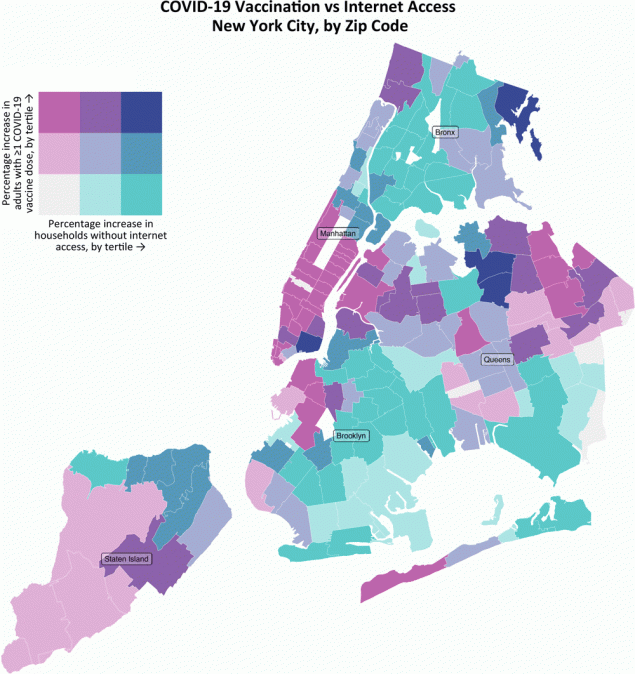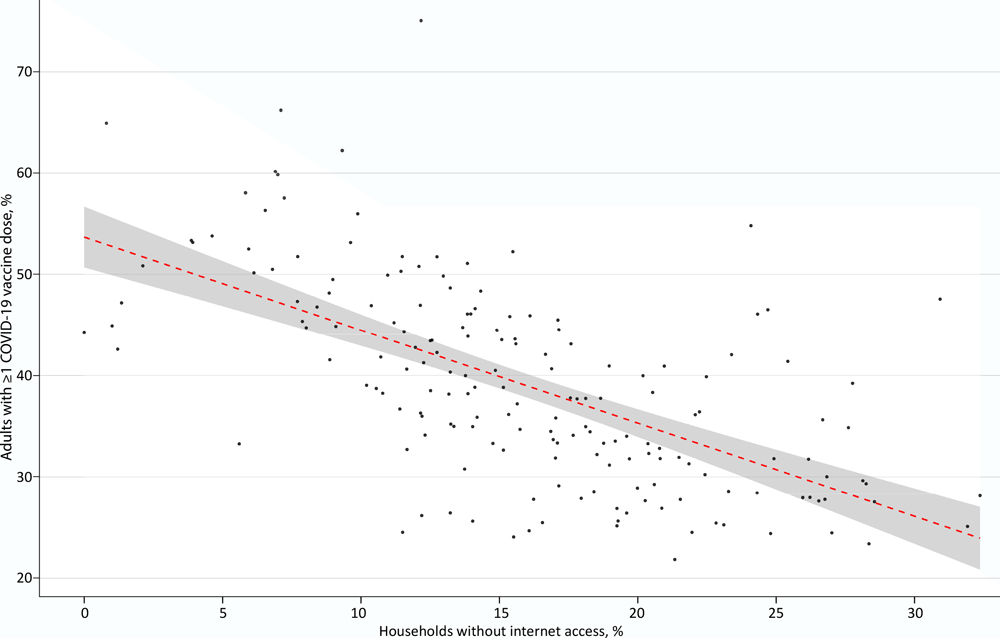
Disparities in Internet Access and COVID-19 Vaccination in New York City
GIS SNAPSHOTS — Volume 18 — August 26, 2021
Isaac H. Michaels, MPH1; Sylvia J. Pirani, MS, MPH2; Alvaro Carrascal, MD, MPH1 (View author affiliations)
Suggested citation for this article: Michaels IH, Pirani SJ, Carrascal A. Disparities in Internet Access and COVID-19 Vaccination in New York City. Prev Chronic Dis 2021;18:210143. DOI: http://dx.doi.org/10.5888/pcd18.210143.
PEER REVIEWED

High-resolution JPG for printimage icon
A bivariate choropleth map that visualizes zip code–level data on household internet access and COVID-19 vaccination in New York City. The map identifies zip codes where the greatest disparities exist. Most disparities are in the Bronx and Brooklyn. This information could be used to place appointment-free vaccination sites in the short term and augment digital education and broadband internet access in the long term. Data on internet access were retrieved from NYC Open Data on April 7, 2021. Vaccination data were retrieved from the New York City Department of Health and Mental Hygiene on April 7, 2021. [A tabular version of this figure is also available.]
Background
Although COVID-19 is a communicable disease, for many people it could also be a chronic disease (1). In New York City, COVID-19 has had a greater effect on older populations, people living in the outer boroughs of the city’s 5 boroughs (eg, the Bronx, Brooklyn, and Queens, compared with Manhattan), people living in poverty, and racial/ethnic minority populations (2). The availability of a COVID-19 vaccine can lessen the effect of the disease on these populations. As of this writing (April 15, 2021), people in New York City had to schedule an appointment to be vaccinated (3), with certain exceptions (4). Many New Yorkers who wanted to be vaccinated were not able to secure appointments, in part because the supply of COVID-19 vaccine was limited (5). Many public health and health care providers use online systems to schedule appointments; as a result, lack of internet access has been suggested as a potential barrier to vaccination (6). We created a map to visualize the community-level distribution of household internet access and COVID-19 vaccination in New York City.
Data and Methods
We obtained estimates of the percentage of households lacking internet access, by zip code, from NYC Open Data (7). Data on internet access were collected by the 2018 5-year American Community Survey. According to NYC Open Data, the American Community Survey frames this question as having “No access to the internet at this house, apartment, or mobile home.”
We obtained data on zip code–level percentages of adult residents who received at least 1 COVID-19 vaccine dose from the New York City Department of Health and Mental Hygiene website (8). The vaccination data were obtained from the Citywide Immunization Registry. According to the source data table, “People with at least one dose have received at least one dose of two-dose vaccine series or a single dose shot.”
We calculated via simple linear regression the association between the percentage of households without internet access and the percentage of adult residents with at least 1 COVID-19 vaccine dose. Internet access and vaccination data were available for all populated (n = 177) modified zip code tabulation areas in New York City (9). We then classified zip codes into 3 internet-access quantiles (tertiles) and 3 COVID-19 vaccination quantiles and visualized them via a bivariate choropleth map (10). We developed the map in R version 4.0.4 (R Foundation for Statistical Computing) by using the tidyverse (11), sf (12), biscale (13), and cowplot (14) packages. All data were retrieved on April 7, 2021.
Highlights
Among zip codes in New York City, the median percentage of households without internet access was 15.5% (SD, 6.7%), ranging from 0% (zip code 10282, Battery Park City, Manhattan) to 32.4% (zip code 10454, Mott Haven/Port Morris, the Bronx). The median percentage of adults that received at least 1 dose of COVID-19 vaccine was 38.2% (SD, 10.0%), ranging from 21.9% (zip code 11691, Edgemere/Far Rockaway, Queens) to 75.0% (zip code 11697, Breezy Point, Queens). In the simple linear regression model, the percentage of households without internet access was negatively associated with the percentage of adult residents who received at least 1 dose of COVID-19 vaccine (β = −0.92; 95 CI, −1.09 to −0.75; intercept = 53.7%; P < .001, adjusted R2 = 0.38) (Figure). Most disparities were in the Bronx and Brooklyn.

![]()
Figure.
Association in New York City, at the zip code level, between the percentage of households without internet access and the percentage of adult residents with at least 1 COVID-19 vaccine dose. Each point represents 1 zip code. The dashed line represents a simple linear regression model, and the shaded area indicates 95% CIs. Linear regression summary: β = −0.92; 95 CI, −1.09 to −0.75; intercept = 53.7%; P< .001; adjusted R2= 0.38. Data sources: New York City Department of Health and Mental Hygiene (8), NYC Open Data (7). Data retrieved on April 7, 2021. [A tabular version of this figure is also available.]
Action
COVID-19 vaccination was significantly associated with household internet access in New York City at the zip code level. Although this association neither implies nor precludes causation, and does not control for possible confounders, it is consistent with the hypothesis that lack of internet access is a barrier to vaccination. Internet access is a known social determinant of health (15).
Disparities in internet access exist across multiple socioeconomic dimensions and disproportionately affect low-income neighborhoods (16). A digital health divide in the older population has been widely documented (17). A study published in 2021 suggested that the digital health divide is associated with age, education, income, and race/ethnicity (18).
To facilitate equitable and efficient COVID-19 vaccine uptake in New York City, public health officials should establish appointment-free vaccination sites, work with other agencies and organizations to advocate for legal and policy approaches that increase internet access (19), and increase access to in-person and telephone-based services that provide assistance with vaccine appointment scheduling, especially in zip codes with low rates of internet access. Our map can be used to inform the placement of such interventions. Because most disparities in internet access and vaccination were in zip codes in the Bronx and Brooklyn, appropriate partners for public health officials in these areas include the offices of the borough president, the borough-based New York City Department of Health and Mental Hygiene Neighborhood Health Action Centers, and borough-wide community-based organizations. More generally, we recommend that bivariate mapping be considered when selecting methods for comparing geographic distributions of health determinants and health outcomes.
The availability and accessibility of COVID-19 vaccine in New York City has continued to improve. After this writing, home-based vaccination, appointment-free walk-up vaccination sites, mobile vaccination sites, and pop-up vaccination sites were established (20).
Acknowledgments
No financial support was received for this work. No copyrighted surveys, instruments, or tools were used. The authors have no conflicts of interest.
Author Information
Corresponding Author: Isaac H. Michaels, MPH, 3100 Rosendale Rd, Niskayuna, NY 12309. Telephone: 347-687-9719. Email: imichaels@albany.edu.
Author Affiliations: 1Department of Epidemiology and Biostatistics, University at Albany School of Public Health, Rensselaer, New York. 2HRSA Funded Region 2 Public Health Training Center, Columbia University Mailman School of Public Health, Department of Sociomedical Sciences, New York, New York.
References
- Couzin-Frankel J. The long haul. Science 2020;369(6504):614–7. CrossRef PubMed
- Thompson CN, Baumgartner J, Pichardo C, Toro B, Li L, Arciuolo R, et al. COVID-19 outbreak — New York City, February 29-June 1, 2020. MMWR Morb Mortal Wkly Rep 2020;69(46):1725–9. CrossRef PubMed
- New York State Department of Health. COVID-19 vaccine. Frequently asked questions. https://covid19vaccine.health.ny.gov/frequently-asked-questions-0. Accessed April 7, 2021.
- Channel 4 NBC News New York. NYC expands vaccine walk-in option to 31 sites; see full list and location hours here. March 30, 2021. Updated April 8, 2021. https://www.nbcnewyork.com/news/coronavirus/no-appointment-no-problem-these-nyc-mass-vaccine-sites-now-allow-some-walk-ins/2972523. Accessed April 11, 2021.
- Gold M. All adults in New York will be eligible for vaccination next week. The New York Times. March 29, 2021. https://www.nytimes.com/2021/03/29/nyregion/new-york-vaccine-eligibility.html. Accessed April 7, 2021.
- Fung K. The digital divide is keeping many NYC seniors from scheduling COVID-19 vaccinations. Gothamist. February 16, 2021. https://gothamist.com/news/digital-divide-keeping-many-nyc-seniors-scheduling-covid-19-vaccinations. Accessed April 7, 2021.
- Mayor’s Office of the Chief Technology Officer. Broadband adoption and infrastructure by zip code. NYC Open Data. October 2, 2020. https://data.cityofnewyork.us/City-Government/Broadband-Adoption-and-Infrastructure-by-Zip-Code/qz5f-yx82. Accessed April 7, 2021.
- City of New York. COVID-19: data. https://www1.nyc.gov/site/doh/covid/covid-19-data-vaccines.page. Accessed April 7, 2021.
- City of New York. New York City Open Data. Modified zip code tabulation areas (MODZCTA). May 19, 2020. https://data.cityofnewyork.us/Health/Modified-Zip-Code-Tabulation-Areas-MODZCTA-/pri4-ifjk. Accessed June 6, 2021.
- Biesecker C, Zahnd WE, Brandt HM, Adams SA, Eberth JM. A bivariate mapping tutorial for cancer control resource allocation decisions and interventions. Prev Chronic Dis 2020;17:E01. CrossRef PubMed
- Wickham H, Averick M, Bryan J, Chang W, McGowan LD, François R, et al. Welcome to the tidyverse. J Open Source Softw 2019;4(43):1686. CrossRef
- Pebesma E. Simple features for R: standardized support for spatial vector data. R J 2018;10(1):439–46. CrossRef
- Prener C, Grossenbacher T, Zehr A. Biscale: tools and palettes for bivariate thematic mapping. R package version 0.2.0. https://CRAN.R-project.org/package=biscale. Accessed April 7, 2021.
- Wilke CO. Cowplot: streamlined plot theme and plot annotations for ‘ggplot2’. R package version 1.1.1. https://CRAN.R-project.org/package=cowplot. Accessed April 7, 2021.
- Sieck CJ, Sheon A, Ancker JS, Castek J, Callahan B, Siefer A. Digital inclusion as a social determinant of health. NPJ Digit Med 2021;4(1):52.”https://www.ncbi.nlm.nih.gov/entrez/query.fcgi?cmd=Retrieve&db=PubMed&list_uids=33731887&dopt=Abstract” CrossRef PubMed
- Mayor’s Office of the Chief Technology Officer. Truth in broadband: access and connectivity in New York City. April 2018. https://www1.nyc.gov/assets/cto/downloads/truth-in-broadband/NYC-Connected-Broadband-Report-2018.pdf. Accessed April 9, 2021.
- Levine DM, Lipsitz SR, Linder JA. Trends in seniors’ use of digital health technology in the United States, 2011–2014. JAMA 2016;316(5):538–40. CrossRef PubMed
- Tappen RM, Cooley ME, Luckmann R, Panday S. Digital health information disparities in older adults: a mixed methods study. J Racial Ethn Health Disparities 2021;1–11.”https://www.ncbi.nlm.nih.gov/entrez/query.fcgi?cmd=Retrieve&db=PubMed&list_uids=33415705&dopt=Abstract” PubMed
- Bauerly BC, McCord RF, Hulkower R, Pepin D. Broadband access as a public health issue: the role of law in expanding broadband access and connecting underserved communities for better health outcomes. J Law Med Ethics 2019;47(S2):39–42. CrossRef PubMed
- City of New York. Vaccine command center. https://www1.nyc.gov/site/coronavirus/vaccines/covid-19-vaccines.page. Accessed June 8, 2021.
The opinions expressed by authors contributing to this journal do not necessarily reflect the opinions of the U.S. Department of Health and Human Services, the Public Health Service, the Centers for Disease Control and Prevention, or the authors’ affiliated institutions.